Rufous will always have a special place in my heart. As a longtime Shaver’s Creek Aviary volunteer, and now staff member, I’ve had the wonderful privilege to help care for and get to know many of the Center’s avian ambassadors over the years. Each one is a cherished individual, but one of my proudest achievements as a volunteer was transforming a timid little Eastern Screech Owl into one of our program’s most steady and outgoing ambassadors.
Rufous came to Shaver’s Creek so long ago that there are conflicting records about when, exactly, he joined our “flock.” What we do know is that in either 1999 or 2002, Rufous moved into his new home at Shaver’s Creek from a Blair County wildlife rehabilitator, having been deemed non-releasable due to a missing eye. Because he was already an adult bird when rescued, we never knew Rufous’ exact age, only that he was at least one year old when he joined our team over two decades ago — back when I was in the early elementary grades and before some of our wildlife caretakers had even been born!
Depending on which set of records is correct, Rufous lived to the very ripe old age of at least 22, and potentially older than 25, far exceeding his species’ average wild lifespan of 8–10 years. As far as I’m aware, Rufous beat all known longevity records for Eastern Screech Owls in human care, and it’s very possible that he may have been the oldest Eastern Screech Owl ever recorded!
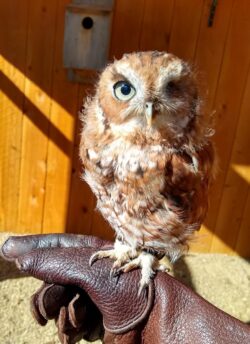 During Rufous’ long career as an ambassador for his species, he touched the lives of thousands. His calm, curious nature and willingness to engage with training sessions made him a wonderful feathered teacher to aspiring animal trainers. Rufous was the first animal that hundreds of volunteers, students, and young professionals ever learned to work with. He was almost always eager to step up on a glove and participate in educational talks, giving many visitors their first up-close look at an Eastern Screech Owl.
During Rufous’ long career as an ambassador for his species, he touched the lives of thousands. His calm, curious nature and willingness to engage with training sessions made him a wonderful feathered teacher to aspiring animal trainers. Rufous was the first animal that hundreds of volunteers, students, and young professionals ever learned to work with. He was almost always eager to step up on a glove and participate in educational talks, giving many visitors their first up-close look at an Eastern Screech Owl.
I first met Rufous in 2008 while attending day camp at Shaver’s Creek as a middle-schooler. I vividly remember a staff member bringing out a tiny, rather scruffy-looking owl with no name, one eye, and rust-colored feathers. I immediately fell in love — not just with the little owl, but with Shaver’s Creek as a whole. As soon as I turned 16, I started volunteering in the Aviary and never looked back.
One of my favorite things about working with the wildlife education program at Shaver’s Creek is that it is a very dynamic field, constantly evolving to be on the forefront of the latest, best practices for animal care and welfare. Throughout the mid-2010s, the program was undergoing a dramatic and positive shift away from simply taking animals on programs and toward building lasting relationships of trust between our resident animals and their human caretakers. In 2017, I took on the task of building that relationship with Rufous.
Anyone who has met Rufous over the past few years will find this hard to believe, but he used to be one of the most timid birds at Shaver’s Creek. Before I started working with him, he would spend all day in his nest box and was rarely visible in his mew whenever people were around. He also didn’t have an official name, having entered Shaver’s Creek during a time when ambassador animals weren’t routinely given names. I came up with the name “Rufous” for him, since his rusty red plumage indicated that he was what ornithologists call a rufous phase screech owl (Eastern Screech Owls can have red, grey, or brown plumage, with each color called a “phase”).
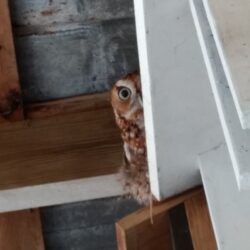 I spent many a lazy summer afternoon sitting in Rufous’ mew for hours and gently talking to him after delivering his food, hoping that he would eventually associate me, and other human caretakers, with his favorite food: a tasty piece of mouse! After several weeks of patience, my efforts paid off. I still have the picture from the first time he came out of his nestbox to grab his food while I was present.
I spent many a lazy summer afternoon sitting in Rufous’ mew for hours and gently talking to him after delivering his food, hoping that he would eventually associate me, and other human caretakers, with his favorite food: a tasty piece of mouse! After several weeks of patience, my efforts paid off. I still have the picture from the first time he came out of his nestbox to grab his food while I was present.
After that first display of trust, Rufous’ training progressed rapidly. Thanks to lots of patience, repetition, and reward, Rufous quickly learned his new name, how to land on a scale, and how to “step up” onto a glove. He now understood that we were not there to harm him and began associating people with positive things, which is ideal for any animal in human care. Like most owls, Rufous’ acute senses made him easily distracted, but with patience and sensitivity to his needs, his caretakers worked with him to unlock his hidden potential. Within a year, Rufous’ behavior was completely transformed and we got to meet the sweet, inquisitive little bird that had been hiding in the nestbox for so long. Rufous was spending more time outside and in the view of visitors, and would eagerly approach trainers who entered his mew to “offer” the behaviors that he knew. In the avian training field, it had been almost unheard of for a mature, parent-reared owl to take so readily to training, and his ability to form new relationships with his caretakers impressed many experts we talked to. Rufous proved that you really can teach an old owl new tricks.
Rufous was lucky to spend his golden years in a freshly renovated mew featuring plenty of space for him to fly and stretch his wings, his favorite “tree” of perches built for him by a volunteer, and lots of high platforms where he could spend his days roosting in the warm sunshine while keeping a close eye on everything, and everyone, in the aviary. In recent years, he often reminded me of an old man, spending his days in a rocking chair on the front porch and watching over the neighborhood.
I was very lucky to have had a wonderful relationship with Rufous for over 13 years. I will certainly miss his sweet little trills, the way he looked like a fuzzy dandelion during his molts, his curiosity towards cellphones and new enrichment, and his eagerness to interact with me and his other caretakers. He was truly a one of a kind bird and I will always miss him, but I look forward to honoring his memory by helping to make the world a better place for all owls through continued care and advocacy.
For anyone interested in making a donation in remembrance of Rufous, please consider becoming an Honorary Animal Caretaker. Donations will go on to support all of our avian ambassadors.
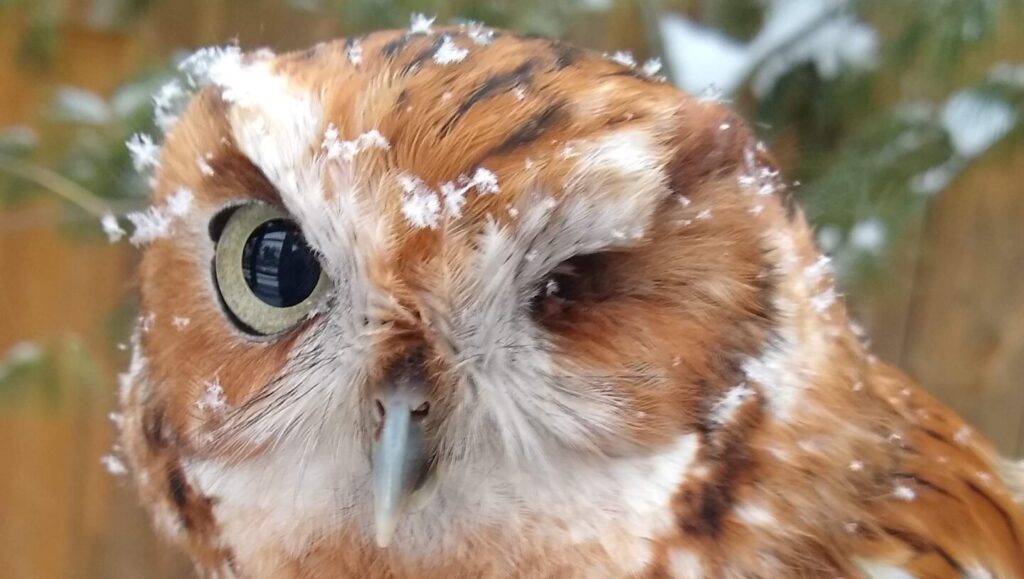
All photos courtesy of Mary Krupa.

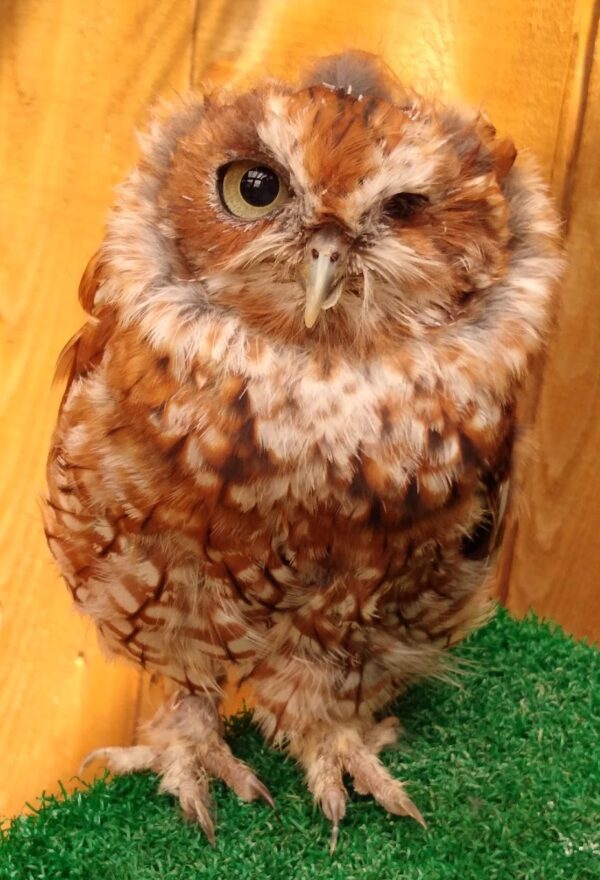
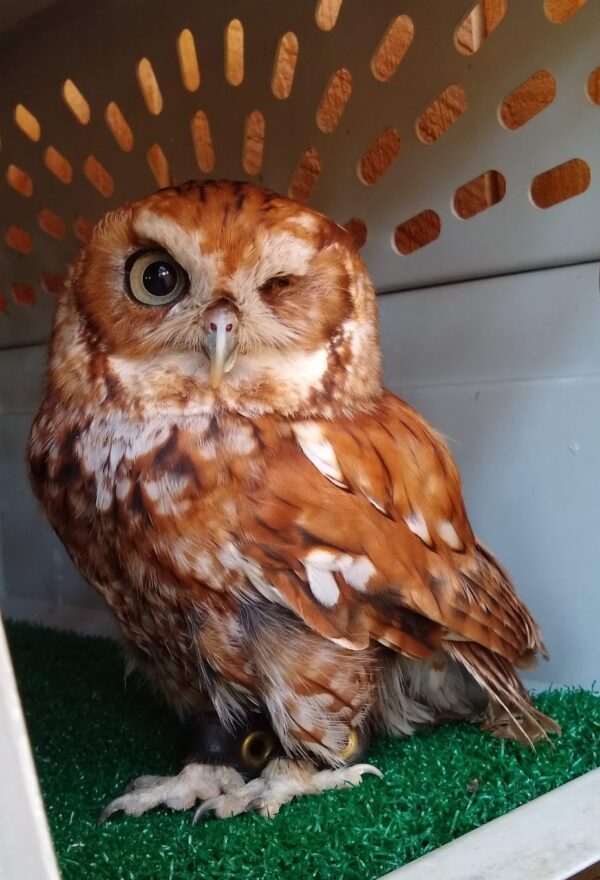
Mary, thank you for your time and devotion to the avian ambassadors of Shaver’s Creek. For so many years, especially those transformative ones, Rufous’s life and welfare was enriched with you as a caretaker! Thank you for sharing your story and memories with us.
Mary, thank you for this lovely remembrance! What a sweet glimpse into Rufous’s life and personality… and the powerful bonds and learnings we can glean from patient and caring volunteers and staff like yourself!
I loved Rufous. I was the volunteer who helped build that ‘tree’ in his new enclosure, and he was the first bird who I was allowed to feed. It gave me such joy to have him perch on my arm, and see him attack his food with such vigor, despite his diminutive size. Lovely Rufous will be missed by many….